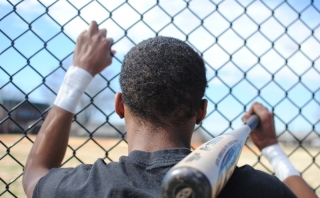By BLAINE WOOTEN – Sports Writer
The color line in baseball was crossed in 1946 by Jackie Robinson, but in the decades since there has been a decrease in participation among African-Americans at the high school, college and Major League level.
The numbers are clear: African-Americans are underrepresented in baseball.
According to the Institute for Diversity and Ethics in Sports, African-American players made up 17 percent of Major League Baseball in 1990. Since then, that percentage has decreased nearly every year and stood at 8.5 percent in 2011.
In contrast, the National Football League consists of 67 percent African-American players, while nearly 85 percent of all players in the National Basketball Association are African-American.
During the 2011 season, there were five African-American players on CCHS varsity team. In 2009 and 2010, there were three and four, respectively.
There are currently three African-American players on the varsity baseball roster for Clarke Central High School, including CCHS freshman Chris Resby.
“There aren’t many African-Americans who play baseball, so it’s not really that diverse. A lot of blacks won’t play because of that,” Resby said.
African-American baseball players are becoming rarer, and the decline has been noticeable since Jackie Robinson first broke the color barrier in baseball in 1946.
“I remember growing up hearing stories from my father and his friends about Jackie Robinson,” former CCHS baseball coach Derron Street said.
Growing up in South Georgia, Street was inspired to play after growing up watching high-profile African-American baseball players, such as Ozzie Smith, Rickey Henderson, Bo Jackson and Ken Griffey, Jr.
Street played baseball throughout his life and discovered that his participation in high school conflicted with other spring sports.
“I remember wanting to run track and play baseball in high school, but I was told by coaches that I had to choose a sport,” Street said.
Street now feels that having both baseball and track in the spring prevents some athletes from having the time to participate in baseball.
“Other African-American student athletes may be more comfortable running track because they may not have had the opportunity to develop the skills needed to play baseball,” Street said.
Street first became associated with the CCHS baseball team when he became a JV coach in 2003.
“I remember being very surprised with the lack of diversity on the baseball team the first year I coached,” Street said.
In 2005, Street was promoted to an assistant varsity baseball coach. That year, he was subject to a discriminatory act on the field.
“There was one situation that occurred after a varsity baseball game at CCHS during the spring of 2005. A varsity student athlete from the visiting team yelled at one of our African-American players and myself,” Street remembered. “It was immediately after we lost a very close game and the tone that athlete used was so derogatory. It was a harsh reminder that unfortunately there is still much work to be done.”
For occurrences such as this to be eradicated from baseball, one of the first steps would be to get players and fans accustomed to seeing players of color in the sport. However, this is becoming increasingly difficult as the lack of African-American interest in baseball is prevalent not only at CCHS, but at many high schools in the US.
“I recruited all over the southeast, and you just don’t see (African-American players). And the guys you do see are usually pretty good,” CCHS assistant baseball coach Trey Henson said.
Henson worked for three years as a baseball recruiter at North Georgia College and State University in Dahlonega, Ga. and played baseball for CCHS from 2000-2003.
“We had three or four black players when I played, but (the participation) is about the same (today),” Henson said.
The low numbers of African-American baseball players is noticeable at the high school level and has become a subject of concern in the major leagues, but it is also very apparent at the college level. Recently, some of the oldest traditions of historically black universities and colleges have been affected by the decline of African-American players.

